Rowing - the best cross training for triathletes?
 Karen Parnell
December 22, 2020
Karen Parnell
December 22, 2020
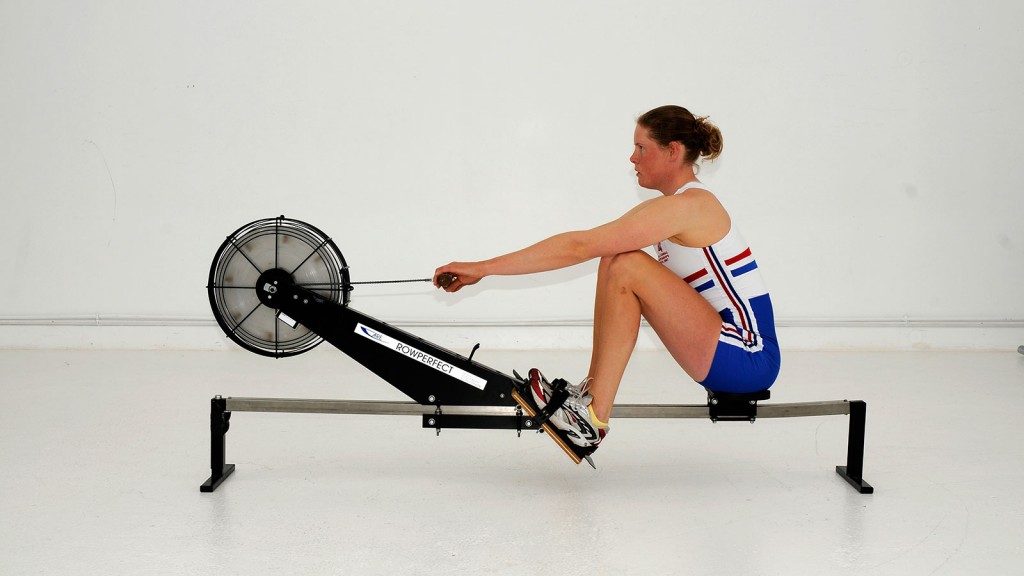
Rowing - the best cross training for triathletes?
Can't get to the pool and your favourite outdoor swimming venue may be too cold even with a wetsuit. But you still need of want to train, what can you do?
You don’t want to lose your cardiovascular fitness and swimming muscle strength built up of the summer and autumn months so is there a good alternative?
If we look at the muscles used for freestyle/front crawl they can be split in to upper and lower body. In the upper body, when swimming front crawl, you’ll use the deltoids (upper shoulder), latissimus dorsi (down the side of your back), trapezius (upper back and neck), triceps and biceps muscles in your arms. The muscles of the shoulders and around shoulder blade (including the deltoids) will help ‘hold’ the ‘paddle’ (your hand and arm) in place as your body moves past it. Your core muscles, including your abdominals, trapezius and latissimus dorsi, help you hold a streamlined torso.
In the lower body, front crawl works the hip flexors, quads, hamstrings, glutes and calves. Your abdominal muscles will also engage from stabilising you in the water.
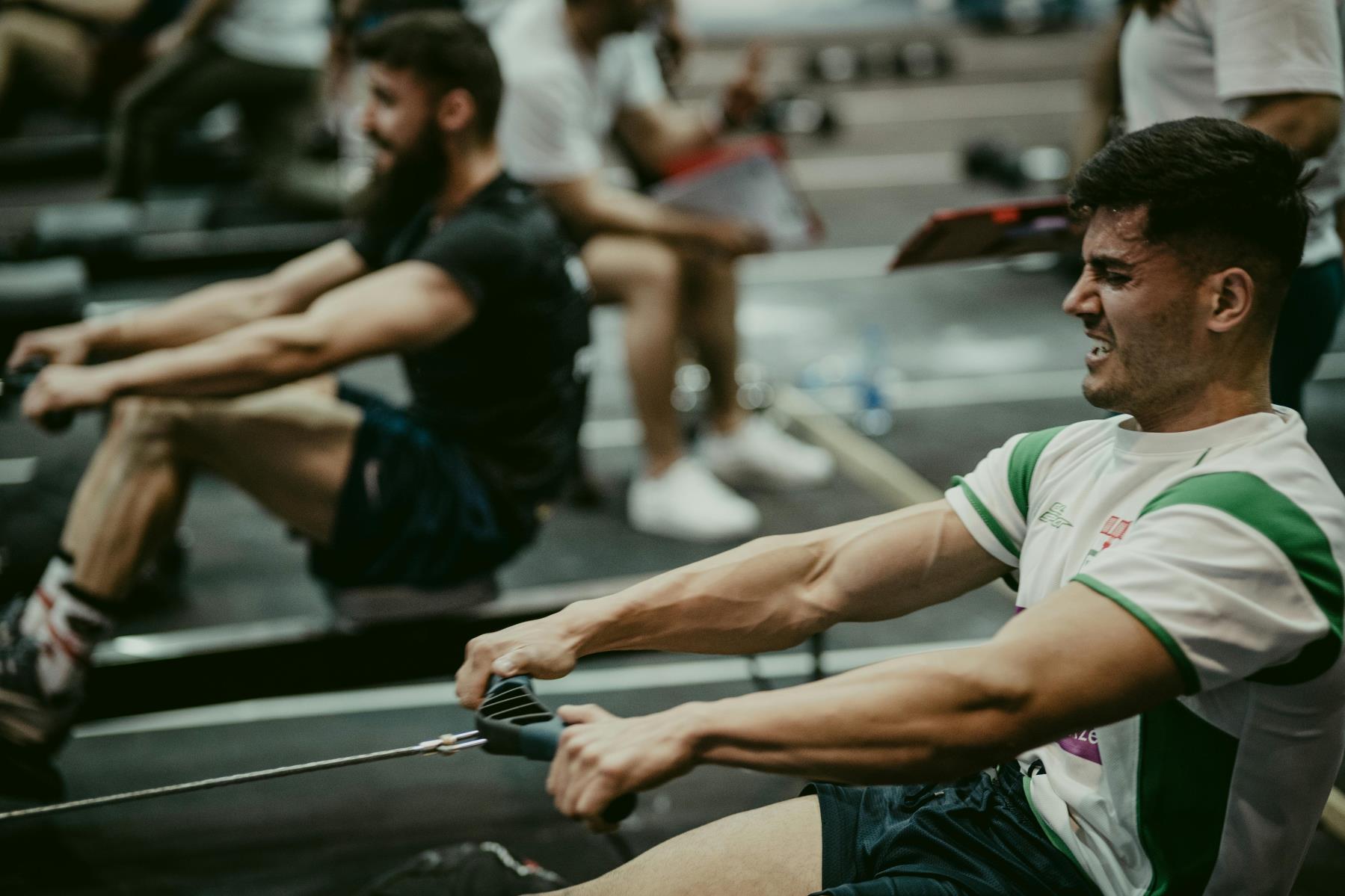
Photo by Ardit Mbrati
5-Week Row Fitness Plan on TrainingPeaks
Swimming Versus Rowing
Swimming is also a great cardiovascular workout and burns about 257 kcals in half an hour. As we know swimming is also a great low impact total body workout.
In the gym the closest we can get with respect to muscles used, calories burned, being low impact and similar cardiovascular stress is the rowing machine. I use a Concept 2 rowing machine which is the benchmark for rowers and not as expensive as you think!
So what muscles does a rowing machine work? Being that it is an almost perfect piece of workout equipment the rowing machine muscles targeted are very similar to that of the swim, Quads, Hamstrings, Glutes, Lats, Core, Shoulders, Triceps, Back and Biceps. In rowing we also use very similar terms for the phases of the stroke they are the Catch, Drive, Finish and Recovery, so lots of commonalty.
These images illustrate the different row positions and phases.
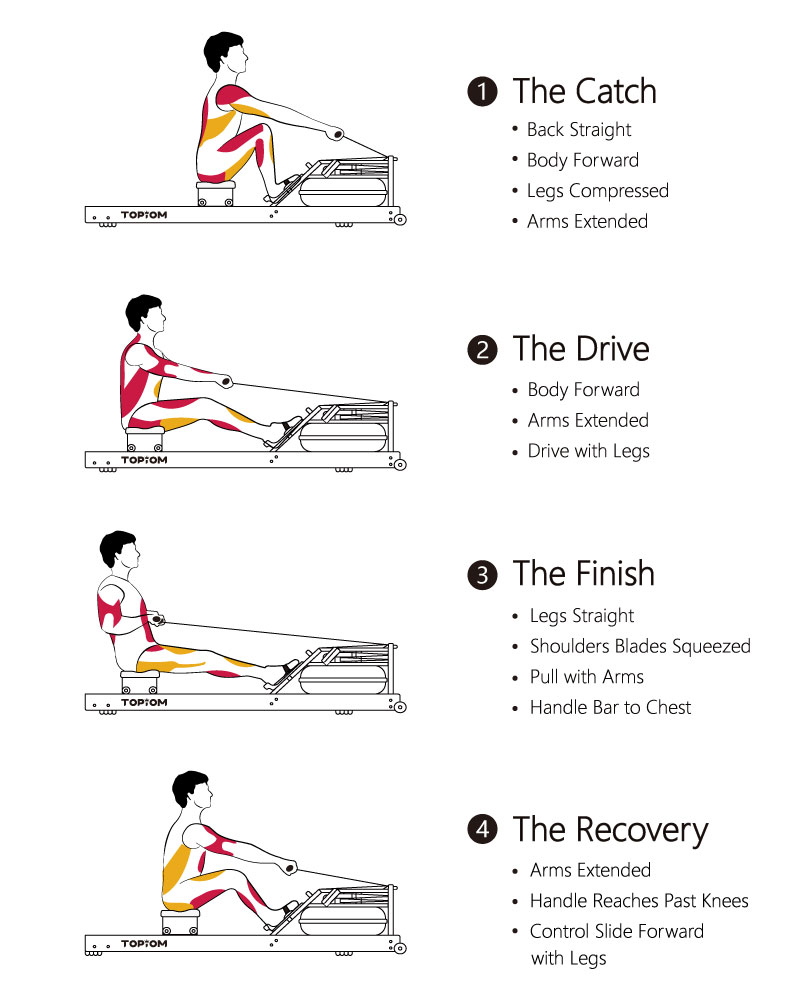
The phases of Rowing which are similar to swimming
Whilst the muscles in each phase are not identical to the swim there is vast read across between the overall muscles used throughout the four phases of both, as can be seen in the table.
Rowing is very similar from a muscles worked perspective but the good news doesn’t end there. During rowing we have a similar cardiovascular response and the calories burned are almost exactly the same at 255 kcals in 30 minutes.
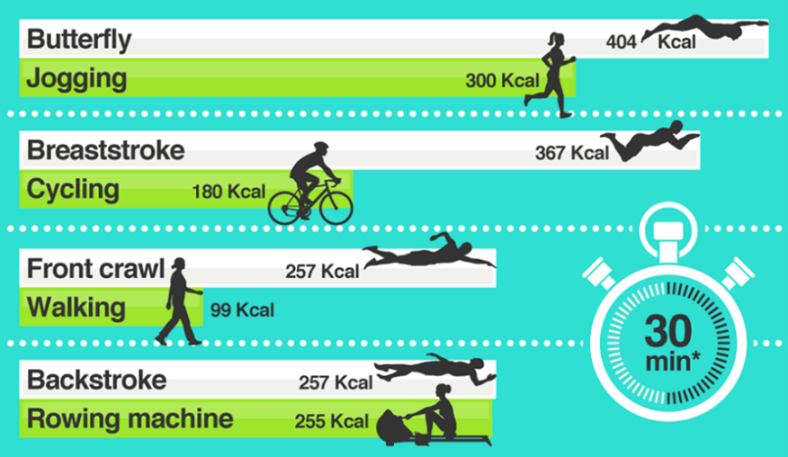
Calories burnt when swimming and rowing

Table showing the muscles used in rowing and swimming
5-Week Row Fitness Plan on TrainingPeaks
Rowing Workouts for Swimmers and Triathletes
Now we know we can substitute some rowing for swimming workouts when needed, what sort of workouts can we do? As with swimming we can do Endurance, Sprints, Fartlek, Intervals and Threshold (similar the CSS sets) sessions. Obviously, we cannot develop swim technique per say but for short periods of time we can develop or keep our muscular and cardiovascular fitness ready for when we get back on the water.
For an endurance session I tend to go with time. For example, if your 400-swim time is 7 minutes and you want to cover the equivalent of a 3000km swim then this would be around 52 min 30 secs of rowing in HR zone 2-3. Note that you will cover a lot more km on the rower, so you may cover around 10km in an hour.
Example Rowing Workouts
Below is an example of a rowing workout you can try:
Threshold (CSS)
Warm up for around 20 minutes with some solid rowing at a resistance level 2-3.
10 minutes into your warmup do a 1-minute pipe opener rating 30 – 32 rowing hard.
Next (after a short break) do 3 x 15 strokes at rate 32, 34 and 36 respectively.
Take around 1-minute easy rowing between each 15-stroke push.
Finally do some easy rowing for 2 – 3 minutes and get ready for the actual rowing session.
Set 1 – resistance level 5-7
Row hard at 32 strokes per minute for 30 seconds, then drop the rate down to 30 for the next 30 seconds.
Repeat this wave for a total of 5 minutes.
In other words, you will do each rate (30 and 32) 5 times in a row at 30 seconds each continuously for 5 minutes.
Take 5 minutes easy rowing and repeat the 30 second rowing wave for 5 minutes.
After that take 5 minutes easy rowing again and repeat the wave a third time.
Row easily for 5 minutes and take a short break.
7 minutes after finishing the 3rd rowing wave begin the next phase.
Set 2 – resistance level 5-7
12 minutes steady rowing rate 28.
Focus on power and rhythm developed in the 5-minute wave phase.
Take a 5-minute rest and repeat the 12-minute workout.
Warm down in the usual way with easy rowing taking your heart rate and resistance level down to 2.
Static stretch out well after each workout using static stretches and foam rolling.
If you want a row training plan to improve your rowing fitness and techique I have written a 5-week programme on TrainingPeaks. The plan includes follow along videos, structured workouts and rowing tips.
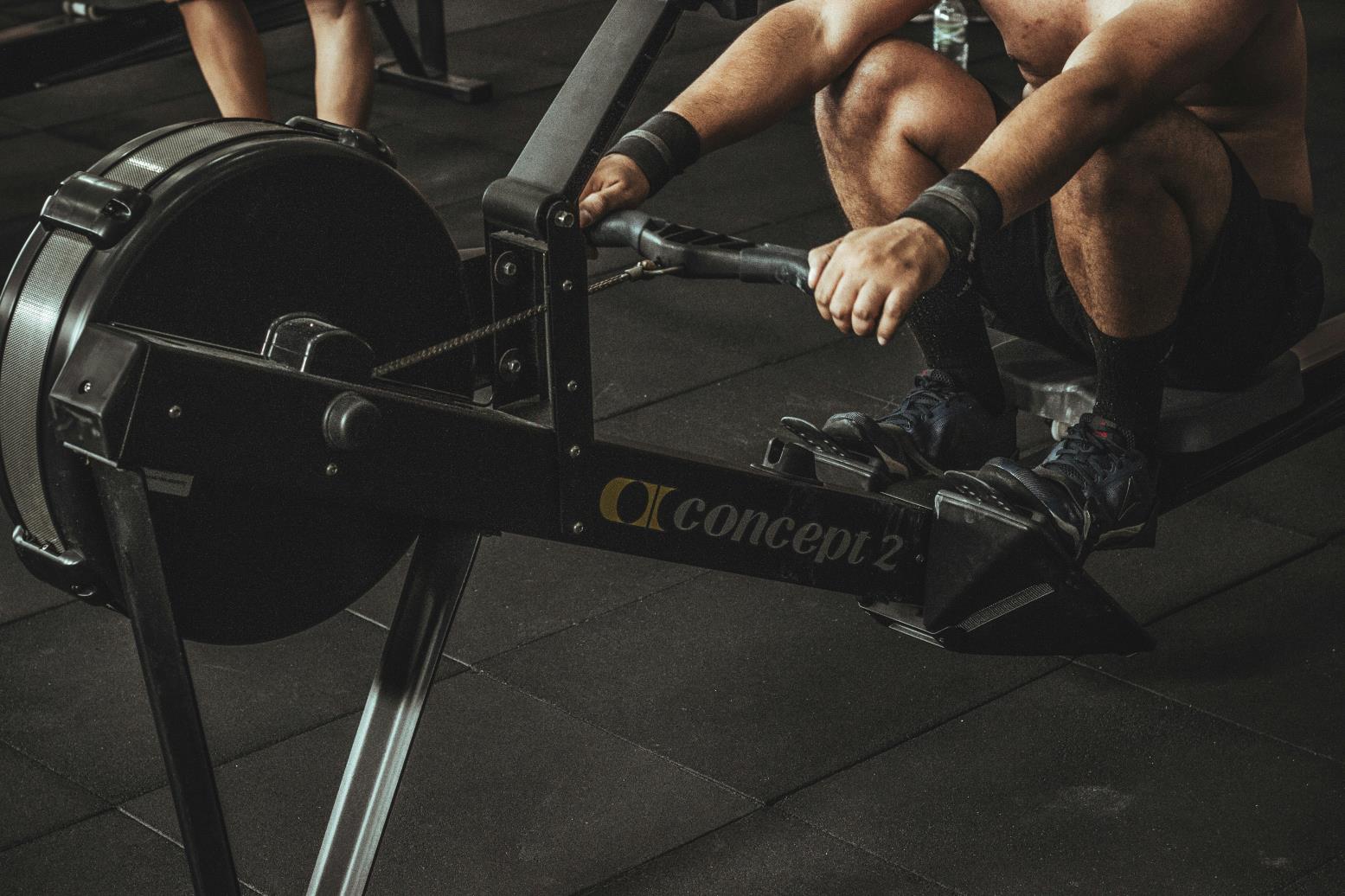
5-Week Row Fitness Plan on TrainingPeaks
Conclusion: Interesting other Benefits of Rowing
I have been experimenting with using rowing using my Concept 2 rower instead of some of my swims and have found that my run CV and strength has improved on both the bike and the run. It will be interesting if you see the same benefits. If you do want to try rowing then the Concept 2 is still the gold standard for rowing and most widely used by professional rowers. Another alternative is a water rower which give a good feel and workout. At the entry level you can get a good workout on the V-Fit rower.
5-Week Row Fitness Plan on TrainingPeaks
Here are some FREE Zwift Rowing Workouts to get you started Rowing on Zwift!
Did you know you can row on Zwift? Here's how on the Zwift Rowers Facebook group.
Get some FREE resources including training plans here.
Would
you like to talk about your training? Get in touch here.
Karen Parnell is a Level 3 British Triathlon and IRONMAN Certified Coach, 8020 Endurance Certified Coach, WOWSA Level 3 open water swimming coach and NASM Personal Trainer and Sports Technology Writer.
Karen is currently studying for an MSc in Sports Performance Coaching at the University of Stirling.
Need a training plan? I have plans on TrainingPeaks and FinalSurge:
I also coach a very small number of athletes one to one for all triathlon and multi-sport distances, open water swimming events and running races, email me for details and availability. Karen.parnell@chilitri.com
Get your FREE Guide to Running Speed and Technique
Get your FREE Swim Workouts for Triathletes E-book
Get your FREE Open Water Swimming Sessions E-Book
FAQ: Rowing for Swimmers
Why is rowing beneficial for swimmers?
Rowing offers several benefits that complement and enhance the swimming performance of athletes. These benefits include improved cardiovascular endurance, full-body strength and conditioning, enhanced core stability, and increased mental toughness.
How does rowing improve cardiovascular endurance for swimmers?
Rowing is a highly aerobic exercise that engages large muscle groups and requires sustained effort over extended periods. Regular rowing workouts can improve swimmers' cardiovascular endurance, allowing them to swim longer distances without fatigue and maintain higher levels of intensity throughout races or training sessions.
What aspects of strength and conditioning does rowing target for swimmers?
Rowing is a full-body workout that engages the muscles of the legs, core, back, and arms. The leg drive in rowing develops lower body strength and power, which translates into stronger kicks and push-offs in swimming. The pulling motion in rowing strengthens the upper body, including the back and shoulder muscles, aiding in better arm and stroke propulsion during swimming.
How does rowing enhance core stability for swimmers?
Rowing requires a strong and stable core to maintain proper body position and transmit power efficiently. The rotational movements and bracing required in rowing strengthen the core muscles, including the abdominals, obliques, and lower back. A stronger core improves body alignment, stability, and control in the water, leading to better swimming technique and reduced energy wastage.
Can rowing help swimmers develop mental toughness?
Yes, rowing can contribute to the development of mental toughness in swimmers. Rowing workouts often involve high-intensity intervals, long endurance sessions, and mental focus on technique and rhythm. The mental challenges and demands of rowing can help swimmers build resilience, mental fortitude, and the ability to push through discomfort, which translates to improved mental toughness and performance in swimming.
How can swimmers incorporate rowing into their training routine?
Swimmers can incorporate rowing into their training routine through cross-training sessions or off-season workouts. They can use rowing machines (ergometers) at the gym or participate in outdoor rowing activities if available. It's important to start gradually, focusing on proper rowing technique and gradually increasing intensity and duration over time.
Can rowing negatively impact swimmers' swimming technique?
While rowing can provide numerous benefits, it's essential for swimmers to maintain a balance between rowing and swimming-specific training. Excessive rowing without maintaining regular swimming practice can lead to a temporary decline in swimming technique. However, when properly integrated into a well-rounded training program, rowing can be a valuable complement to swimming, improving overall fitness and performance.
Remember, consulting with a coach or trainer experienced in both rowing and swimming can help design a training plan that incorporates rowing effectively into a swimmer's routine while considering individual needs and goals.
References
Ingham, S. et al. (2008, March). Physiological and Performance Effects of Low- versus Mixed-Intensity Rowing Training. Retrieved from https://oce.ovid.com/article/00005768-200803000-00026/HTML
#rowing #triathloncoach #triathlon #swimming #running #cycling #trainingcamps #trianingplans #chilitri #openwaterswimming #swimmingtrainingplan #cyclingtrainingplan #runningtrainingplan #swimming #cycling #running
